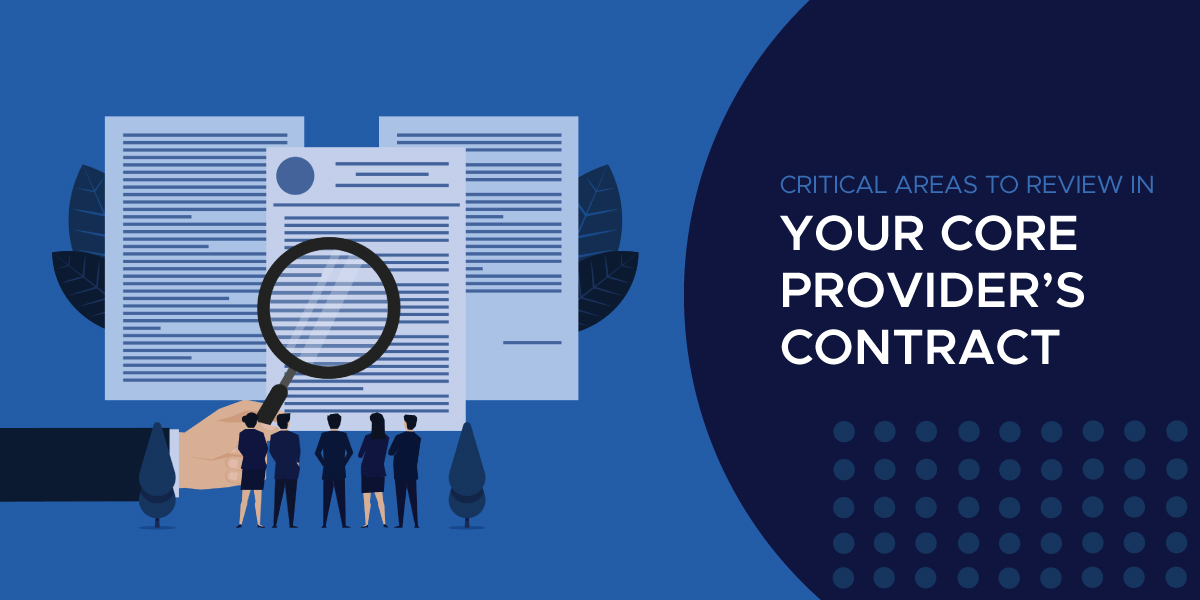Having to review a core provider’s contract is like trying to walk through the southern mud. There are pages and pages of messy legalese, and if you don’t have an attorney that is knowledgeable in core technology contracts, you might just sign up for products and services you don’t need or want, and end up paying for more than you bargained for. What community bankers may not realize is that a core provider’s contract shouldn’t be complex or confusing; yet day after day, bankers are left locked into their contracts due to the black holes they couldn’t spot ahead of signing on the dotted line.
There are certain items you should look out for and ask about to ensure your bank is protected and that you’re only paying for the service you deserve.
Important Areas to Review in Your Core Provider’s Contract
Product and services scope
When you first look at a contract, you want to make sure that all of the products and services you discussed during initial conversations—and that were addressed in the original proposal—are accurately reflected in the contract. You want to avoid having extra service line items in the contract placed there without your consent.
Additionally, you want to make sure the master agreement clearly outlines the agreed upon costs, the respective fee schedule, terms and conditions for each product, auto-renewal information, and any details regarding product updates and new developments. Many vendors often rollout new product features and add-ons with little to no notice and can charge an additional cost for these enhancements whether or not you use them. In many instances, a contract may have language stating your bank will be notified via email once a product or service has been added. This may seem like a courtesy, but you may have not consented to adding another product in the first place.
If you’re unable to spot the elements described above in your master agreement due to the complex legalese, make sure you ask your provider the following questions:
- Does this contact renew automatically after the terms expire?
- Does the agreement buyout decline each year?
- What if I want to make a change to this agreement after we’ve started work?
- Will my system continue to be enhanced, or will I be forced to move to a more up-to-date system sometime in the future?
- Will I be notified before product updates and enhancements rollout? Will there be a charge to use them?
- Can I opt out of product add-ons and new developments?
Product pricing and inflation
Not only do you want to know what the cost of service will be initially, but also if it changes over time so you can budget better. Big-box vendors tend to charge by account, regardless of whether or not it’s active. Charging by transaction volume can easily require more of an investment and impact your business plan if you’re looking to grow your business in the next five to ten years. If that’s not enough, many vendors also charge separately for the technology, which has its own inflation prices. If you’re paying 10 cents for one account, by the end of the year you may end up paying 10.3 cents for 100 accounts plus the cost of technology use.
If the pricing in your contract isn’t clearly spelled out, ask them:
- How does your pricing model work?
- Is there a compounding price increase on products and services over time?
Open API and third-party integrations
A vendor may say they have an open API and can easily integrate with hundreds of third-party providers. But, what really happens is the core may have strict requirements and limitations that may prevent them from integrating with your third-party provider of choice or they will impose a hefty fee for your bank to use the API to integrate with your outside vendor. If an open API and third-party integrations attracted you to the core in the first place, you should make sure these details are clearly described in the contract to avoid disappointment when you propose a new integration later in the partnership.
If third party integration language is complex or missing from the contract, ask them:
- What is the process for integrating with third-party vendors after the contract is signed?
- Is it possible for me to integrate with a third-party vendor of my choice? What is the cost?
- How long does it typically take to deliver a solution from the time I request a new integration?
Addendum terms and conditions
Ideally, all addendums should be coterminous within your master agreement. However, with a big-box core provider it’s common to manage a master agreement with separate terms and conditions for addendums. Too many contracts can become overwhelming, especially when terms and conditions supersede the master. You’re essentially caught managing different terms for different products and can get lost in the process.
Should an addendum occur, ask them:
- When bringing on new products and services, does the master agreement control all amendments?
- Do new products have their own initial term and renewal term?
- Is there a flat fee for the products and services outlined in the addendum or is it based on volume size?
Mergers and acquisitions
Many banks decide to grow their business through acquisitions and mergers. Should you decide to go this route, your contract should be clear on acquisition costs and ongoing product and service fees. Similar to an addendum, terms can vary from contract to contract, so you’ll want to proactively address how these are handled up front to ensure it coincides with your business plan to avoid confusion or frustration in the long-term.
If you know an acquisition or merger could be a possibility for your bank, ask them:
- If I acquire a bank, what is the price to add the bank to my core system?
- What are the ongoing fees and how do they differ from the master agreement?
- If I acquire a bank using the same system, will you waive their early termination fees?
Termination and data deconversion details
Keeping your bank healthy and profitable should always be top of mind. If at some point you decide you want to sell your bank, merge with another bank, or change core providers, you’ll want to know what it takes to do that without hassle. Some vendors impose heavy penalties and fees for ending contracts early or making other significant changes. Be proactive and look for deconversion details in your contract. Even if you believe it would be years before your bank experiences a new milestone, it’s still important to know this information ahead of time.
If deconversion details are absent from the agreement, ask them:
- If at some point my bank needs to terminate service, what does the process look like?
- What are the specific deconversion fees and terms?
- Are there any other termination costs/penalties outside deconversion?
Review Your Contracts with Confidence
There’s no reason why the excitement you feel in bringing on new technology should be stifled by a complex agreement that hits your desk. Your core contract influences major operational and technology decisions at your bank, so it needs to be easy to read and understandable. Learn to identify the key areas and ask the right questions to protect your bank 5, 10, and 15+ years from now. Core technology is a significant investment, so ensure you work with a provider that gives you the confidence to take on new partnerships and is transparent with their scope and deliverables. More importantly, work with a provider that can help you plan for your bank’s future growth without barriers or limitations.
If you're like many community bankers, you're stuck between a rock and a hard place when it comes to the relationship with your existing core provider. Many legacy cores are no longer evolving their suite of products, yet their complex contracts make a bank feel locked in. Additionally, many big-box cores are failing to be agile and responsive to your needs. Ask yourself, "When is enough, enough?" Read our next post to learn from fellow community bankers when it's time to change core providers.





